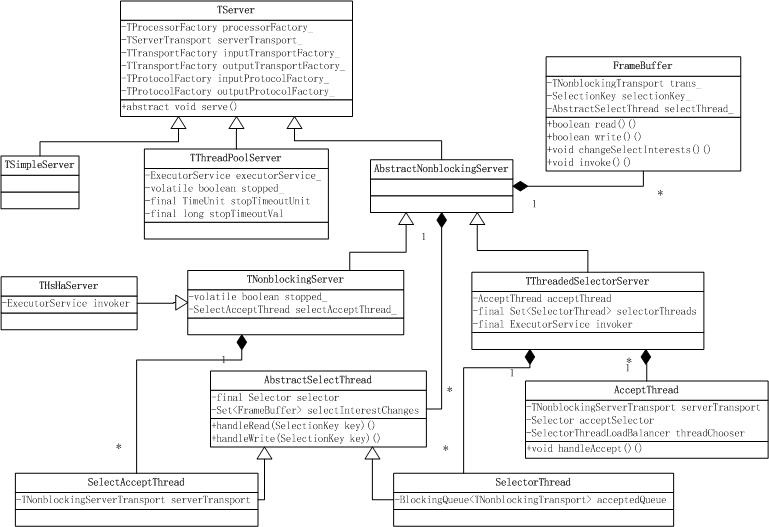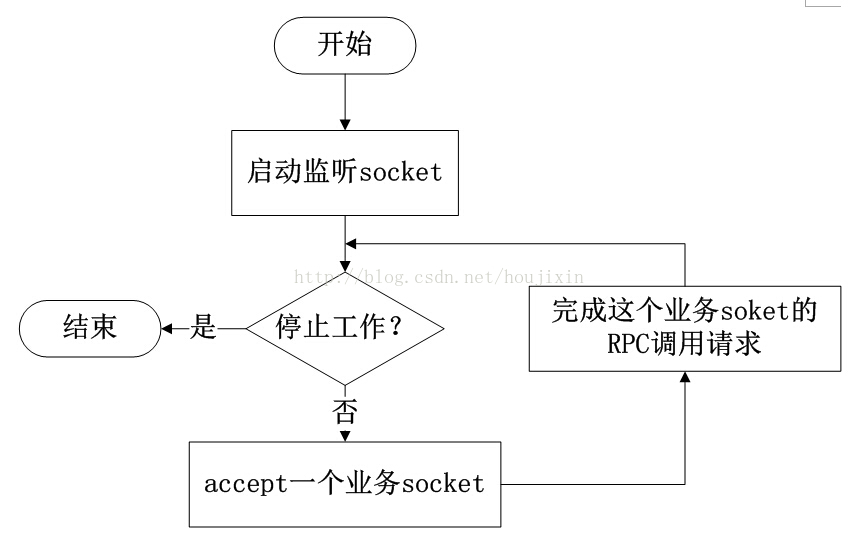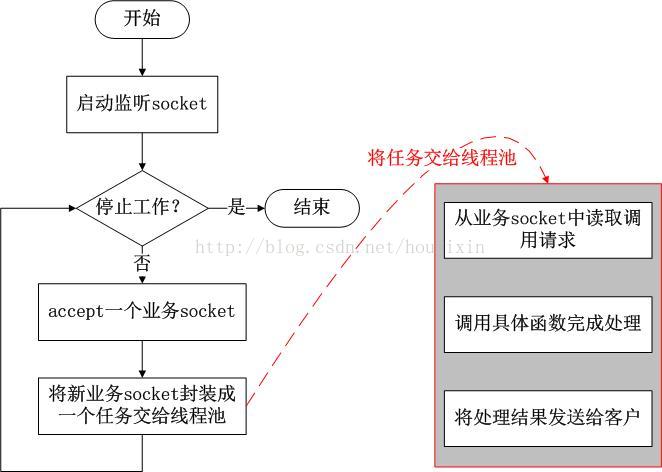RPC-Thrift
Posted 在周末
tags:
篇首语:本文由小常识网(cha138.com)小编为大家整理,主要介绍了RPC-Thrift相关的知识,希望对你有一定的参考价值。
一个简单例子
IDL文件如下,详细的IDL语法参考官方文档http://thrift.apache.org/docs/idl。
通过代码生成工具得到两个文件:HelloService.java和ResultCommon.java。
namespace java com.mytest.thrift struct ResultCommon{ 1:i32 resultCode, 2:string desc } service HelloService{ ResultCommon sayHello(1:string paramJson) }
Thrift业务HelloService.Iface接口的实现如下
public class HelloHandler implements HelloService.Iface { private Logger logger = LoggerFactory.getLogger(HelloHandler.class); @Override public ResultCommon sayHello(String paramJson) throws TException { logger.info("receive request param : {}", paramJson); ResultCommon response = new ResultCommon(); response.setDesc("Hello World!"); return response; } }
Thrift RPC服务端实现
public class RpcServer { public static void main(String[] args) throws TTransportException { //基于阻塞式同步IO模型 TServerSocket tServerSocket = new TServerSocket(8090); HelloService.Processor<Iface> processor = new HelloService.Processor<HelloService.Iface>(new HelloHandler()); Args args1 = new Args(tServerSocket); args1.processor(processor); //消息格式使用二进制 args1.protocolFactory(new TBinaryProtocol.Factory()); //线程池的最大、最小线程数 args1.maxWorkerThreads(10); args1.minWorkerThreads(1); //启动服务 TThreadPoolServer server = new TThreadPoolServer(args1); //在此处阻塞 server.serve(); } }
Thrift RPC客户端实现
public class RpcClient { public static void main(String[] args) throws TException { TSocket tSocket = new TSocket("127.0.0.1", 8090); tSocket.open(); TProtocol tProtocol = new TBinaryProtocol(tSocket); HelloService.Client client = new HelloService.Client(tProtocol); String paramJson = "{\\"wewe\\":\\"111\\"}"; ResultCommon resultCommon = client.sayHello(paramJson); System.out.println(resultCommon.getDesc()); tSocket.close(); } }
注意点:1)Thrift客户端和服务端使用的I/O模型必须一致,上例中都是使用阻塞式同步I/O模型。
2)Thrift客户端和服务端使用的消息格式必须一致,上例中都是使用二进制流格式TBinaryProtocol。
Thrift RPC详解
Thrift协议栈如下图所示:

底层I/O模块:负责实际的数据传输,可以是Socket、文件、压缩数据流等;
TTransport:定义了消息怎样在Client和Server之间进行通信的,负责以字节流的方式发送和接收消息。TTransport不同的子类负责Thrift字节流(Byte Stream)数据在不同的IO模块上的传输,如:TSocket负责Socket传输,TFileTransport负责文件传输;
TProtocol:定义了消息时怎样进行序列化的,即负责结构化数据(如对象、结构体等)与字节流消息的转换,对Client侧是将结构化数据组装成字节流消息,对Server端则是从字节流消息中提取结构化数据。TProtocol不同的子类对应不同的消息格式转换,如TBinaryProtocol对应字节流。
TServer:负责接收客户端请求,并将请求转发给Processor。TServer各个子类实现机制不同,性能也差距很大。
Processor:负责处理客户端请求并返回响应,包括RPC请求转发、参数解析、调用用户定义的代码等。Processor的代码时Thrift根据IDL文件自动生成的,用户只需根据自动生成的接口进行业务逻辑的实现就可以,Processor是Thrift框架转入用户逻辑的关键。
ServiceClient:负责客户端发送RPC请求,和Processor一样,该部分的代码也是由Thrift根据IDL文件自动生成的。
Thrift核心类库实现原理
TServer
主要负责接收并转发Client的请求。TServer的类结构图如下:

Thrift提供了多种TServer的实现,不同的TServer使用了不同的模型,适用的情况也有所不同。
TSimpleServer:阻塞I/O单线程Server,主要用于测试;
TThreadPoolServer:阻塞I/O多线程Server,多线程使用Java并发包中的线程池ThreadPoolExecutor。
AbstractNonblockingServer:抽象类,为非阻塞I/O Server类提供共同的方法和类。
TNonblockingServer:多路复用I/O单线程Server,依赖于TFramedTransport;
THsHaServer:半同步/半异步Server,多线程处理业务逻辑调用,同样依赖于TFramedTransport;
TThreadedSelectorServer:半同步/半异步Server,依赖于TFramedTransport。
下面详细分析一下各个TServer的实现原理
TSimpleServer
TSimpleServer每次只能处理一个连接,直到客户端关闭了连接,它才回去接受一个新的连接,正因为它只在一个单独的线程中以阻塞I/O的方式完成这些工作,所以它只能服务一个客户端连接,其他所有客户端在被服务器端接受之前都只能等待。TSimpleServer的效率很低,不能用在生产环境。通过源码具体分析实现机制。
public void serve() { stopped_ = false; try { //启动监听Socket serverTransport_.listen(); } catch (TTransportException ttx) { LOGGER.error("Error occurred during listening.", ttx); return; } setServing(true); //置状态为正在服务 //一次只能处理一个Socket连接 while (!stopped_) { TTransport client = null; TProcessor processor = null; TTransport inputTransport = null; TTransport outputTransport = null; TProtocol inputProtocol = null; TProtocol outputProtocol = null; try { client = serverTransport_.accept(); //接收连接请求,若没有则一直阻塞 if (client != null) { processor = processorFactory_.getProcessor(client); inputTransport = inputTransportFactory_.getTransport(client); outputTransport = outputTransportFactory_.getTransport(client); inputProtocol = inputProtocolFactory_.getProtocol(inputTransport); outputProtocol = outputProtocolFactory_.getProtocol(outputTransport); //处理该请求直到成功 while (processor.process(inputProtocol, outputProtocol)) {} } } catch (TTransportException ttx) { // Client died, just move on } catch (TException tx) { if (!stopped_) { LOGGER.error("Thrift error occurred during processing of message.", tx); } } catch (Exception x) { if (!stopped_) { LOGGER.error("Error occurred during processing of message.", x); } } if (inputTransport != null) { inputTransport.close(); } if (outputTransport != null) { outputTransport.close(); } } setServing(false); }
由源代码可以分析出,TSimpleServer的处理流程如下:

TThreadPoolServer
TThreadPoolServer也是基于阻塞I/O模型,与TSimpleServer不同的是,它使用线程池来提高效率。
TThreadPoolServer的构造函数如下,使用了JDK并发包提供的线程池ThreadPoolExecutor,可配置最大线程数(默认为Integer.Max)和最小线程数(默认5),线程池的阻塞队列使用的是SynchronousQueue,每个put操作必须等待一个take操作,如果不满足条件,put操作和take操作将会被阻塞。
// Executor service for handling client connections private ExecutorService executorService_; //关闭Server时的最长等待时间 private final TimeUnit stopTimeoutUnit; private final long stopTimeoutVal; public TThreadPoolServer(Args args) { super(args); //同步阻塞队列,每个put操作必须等待一个take操作,没有容量,常用于线程间交换单一元素 SynchronousQueue<Runnable> executorQueue = new SynchronousQueue<Runnable>(); stopTimeoutUnit = args.stopTimeoutUnit; stopTimeoutVal = args.stopTimeoutVal; //初始化线程池 executorService_ = new ThreadPoolExecutor(args.minWorkerThreads, args.maxWorkerThreads, 60, TimeUnit.SECONDS, executorQueue); }
再看一下TThreadPoolServer的serve()方法,主线程专门用来接受连接,一旦接收了一个连接,该Client连接会被放入ThreadPoolExecutor中的一个worker线程里处理,主线程继续接收下一个Client连接请求。由于线程池的阻塞队列使用的是SynchronousQueue,所以TThreadPoolServer能够支撑的最大Client连接数为线程池的线程数,也就是说每个Client连接都会占用一个线程。需要注意的是,当并发的Client连接数很大时,Server端的线程数会很大,可能会引发Server端的性能问题。
public void serve() { try { //启动监听Socket serverTransport_.listen(); } catch (TTransportException ttx) { LOGGER.error("Error occurred during listening.", ttx); return; } stopped_ = false; setServing(true); //如果Server没有被停止,就一直循环 while (!stopped_) { int failureCount = 0; try { //阻塞方式接收Client连接请求,每收到一个Client连接请求就新建一个Worker,放入线程池处理该连接的业务 TTransport client = serverTransport_.accept(); WorkerProcess wp = new WorkerProcess(client); executorService_.execute(wp); } catch (TTransportException ttx) { if (!stopped_) { ++failureCount; LOGGER.warn("Transport error occurred during acceptance of message.", ttx); } } } //Server停止,关闭线程池 executorService_.shutdown(); // Loop until awaitTermination finally does return without a interrupted // exception. If we don\'t do this, then we\'ll shut down prematurely. We want // to let the executorService clear it\'s task queue, closing client sockets // appropriately. //在timeoutMS时间内,循环直到完成调用awaitTermination方法。防止过早的关闭线程池,关闭遗留的client sockets。 long timeoutMS = stopTimeoutUnit.toMillis(stopTimeoutVal); long now = System.currentTimeMillis(); while (timeoutMS >= 0) { try { //awaitTermination方法调用会被阻塞,直到所有任务执行完毕并且shutdown请求被调用,或者参数中定义的timeout时间到达或者当前线程被中断 executorService_.awaitTermination(timeoutMS, TimeUnit.MILLISECONDS); break; } catch (InterruptedException ix) { //如果发生中断异常,继续循环 long newnow = System.currentTimeMillis(); timeoutMS -= (newnow - now); now = newnow; } } setServing(false); }
最后看一下WorkerProcess类。WorkerProcess是TThreadPoolServer的内部类。每个WorkerProcess线程被绑定到特定的客户端连接上,处理该连接上的请求,直到它关闭,一旦连接关闭,该worker线程就又回到了线程池中。
private class WorkerProcess implements Runnable { private TTransport client_; private WorkerProcess(TTransport client) { client_ = client; } public void run() { TProcessor processor = null; TTransport inputTransport = null; TTransport outputTransport = null; TProtocol inputProtocol = null; TProtocol outputProtocol = null; try { processor = processorFactory_.getProcessor(client_); inputTransport = inputTransportFactory_.getTransport(client_); outputTransport = outputTransportFactory_.getTransport(client_); inputProtocol = inputProtocolFactory_.getProtocol(inputTransport); outputProtocol = outputProtocolFactory_.getProtocol(outputTransport); // we check stopped_ first to make sure we\'re not supposed to be shutting // down. this is necessary for graceful shutdown. //循环处理该Client连接的请求,除非Server关闭或连接异常否则一直循环 while (!stopped_ && processor.process(inputProtocol, outputProtocol)) {} } catch (TTransportException ttx) { // Assume the client died and continue silently } catch (TException tx) { LOGGER.error("Thrift error occurred during processing of message.", tx); } catch (Exception x) { LOGGER.error("Error occurred during processing of message.", x); } //关闭inputTransport和outputTransport if (inputTransport != null) { inputTransport.close(); } if (outputTransport != null) { outputTransport.close(); } } }
用流程图表示TThreadPoolServer的处理流程如下:

AbstractNonblockingServer
AbstractNonblockingServer类是非阻塞I/O TServer的父类,提供了公用的方法和类。先通过源码了解它的实现机制。启动服务的大致流程为 startThreads() -> startListening() -> setServing(true) -> waitForShutdown(),具体内容依赖于AbstractNonblockingServer子类的具体实现。基于Java NIO(多路复用I/O模型)实现。
public abstract class AbstractNonblockingServer extends TServer { protected final Logger LOGGER = LoggerFactory.getLogger(getClass().getName()); public static abstract class AbstractNonblockingServerArgs<T extends AbstractNonblockingServerArgs<T>> extends AbstractServerArgs<T> { //读缓冲区的最大字节数 public long maxReadBufferBytes = Long.MAX_VALUE; //设置父类inputTransportFactory_、outputTransportFactory_对象 public AbstractNonblockingServerArgs(TNonblockingServerTransport transport) { super(transport); transportFactory(new TFramedTransport.Factory()); } } private final long MAX_READ_BUFFER_BYTES; //已分配读缓存字节数 private final AtomicLong readBufferBytesAllocated = new AtomicLong(0); public AbstractNonblockingServer(AbstractNonblockingServerArgs args) { super(args); MAX_READ_BUFFER_BYTES = args.maxReadBufferBytes; } /** * Begin accepting connections and processing invocations. */ public void serve() { // start any IO threads 启动IO线程 if (!startThreads()) { return; } // start listening, or exit 开启监听端口,接收Client请求 if (!startListening()) { return; } setServing(true); //置状态为服务中 // this will block while we serve waitForShutdown(); //启动服务后的阻塞方法,Server停止后会解除阻塞 setServing(false); //置状态为服务结束 // do a little cleanup stopListening(); //停止监听端口 } /** * Starts any threads required for serving. * * @return true if everything went ok, false if threads could not be started. */ protected abstract boolean startThreads();//启动IO线程,由子类实现 /** * A method that will block until when threads handling the serving have been * shut down. */ protected abstract void waitForShutdown();//启动服务后的阻塞方法,Server停止后会解除阻塞,由子类实现 //开启监听端口 protected boolean startListening() { try { serverTransport_.listen(); return true; } catch (TTransportException ttx) { LOGGER.error("Failed to start listening on server socket!", ttx); return false; } } //停止监听端口 protected void stopListening() { serverTransport_.close(); } /** * Perform an invocation. This method could behave several different ways - * invoke immediately inline, queue for separate execution, etc. * * @return true if invocation was successfully requested, which is not a * guarantee that invocation has completed. False if the request * failed. */ protected abstract boolean requestInvoke(FrameBuffer frameBuffer);//对frameBuffer执行业务逻辑,由子类实现 }
AbstractNonblockingServer的内部类 FrameBuffer是非阻塞I/O TServer实现读写数据的核心类。FrameBuffer类存在多种状态,不同的状态表现出不同的行为,先看一下FrameBufferState枚举类。
private enum FrameBufferState { // in the midst of reading the frame size off the wire 读取FrameSize的状态 READING_FRAME_SIZE, // reading the actual frame data now, but not all the way done yet 读取真实数据的状态 READING_FRAME, // completely read the frame, so an invocation can now happen 完成读取数据,调用业务处理方法 READ_FRAME_COMPLETE, // waiting to get switched to listening for write events 完成业务调用,等待被转换为监听写事件 AWAITING_REGISTER_WRITE, // started writing response data, not fully complete yet 写response数据状态 WRITING, // another thread wants this framebuffer to go back to reading //完成写response数据,等待另一个线程注册为读事件,注册成功后变为READING_FRAME_SIZE状态 AWAITING_REGISTER_READ, // we want our transport and selection key invalidated in the selector // thread 上面任一种状态执行异常时处于该状态,selector轮询时会关闭该连接 AWAITING_CLOSE }
如果Client需要返回结果,FrameBuffer状态转换过程为: READING_FRAME_SIZE -> READING_FRAME -> READ_FRAME_COMPLETE -> AWAITING_REGISTER_WRITE -> WRITING -> AWAITING_REGISTER_READ -> READING_FRAME_SIZE ;
如果Client不需要返回结果,FrameBuffer状态转换过程为: READING_FRAME_SIZE -> READING_FRAME -> READ_FRAME_COMPLETE -> AWAITING_REGISTER_READ -> READING_FRAME_SIZE ;
如果以上任何状态执行时出现异常,FrameBuffer状态将转换为 AWAITING_CLOSE。
FrameBuffer类的源码分析如下,FrameBuffer与SelectionKey绑定,它实现了从客户端读取数据、调用业务逻辑、向客户端返回数据,并管理阈值绑定的SelectionKey的注册事件的改变。
protected class FrameBuffer { // the actual transport hooked up to the client. private final TNonblockingTransport trans_;//与客户端建立的连接,具体的实现是TNonblockingSocket // the SelectionKey that corresponds to our transport private final SelectionKey selectionKey_;//该FrameBuffer对象关联的SelectionKey对象 // the SelectThread that owns the registration of our transport private final AbstractSelectThread selectThread_;//该FrameBuffer对象所属的selectThread_线程 // where in the process of reading/writing are we? private FrameBufferState state_ = FrameBufferState.READING_FRAME_SIZE;//该FrameBuffer对象的状态 // the ByteBuffer we\'ll be using to write and read, depending on the state private ByteBuffer buffer_;//读写数据时使用的buffer,Java NIO private TByteArrayOutputStream response_;//执行完业务逻辑后,保存在本地的结果 public FrameBuffer(final TNonblockingTransport trans, final SelectionKey selectionKey, final AbstractSelectThread selectThread) { trans_ = trans; selectionKey_ = selectionKey; selectThread_ = selectThread; buffer_ = ByteBuffer.allocate(4);//因为TFramedTransport的frameSize为4-byte,所以分配4字节 } /** * Give this FrameBuffer a chance to read. The selector loop should have * received a read event for this FrameBuffer. * * @return true if the connection should live on, false if it should be * closed */ //读取一次数据,如果状态为READING_FRAME_SIZE,则读取FrameSize;如果状态为READING_FRAME,则读数据 public boolean read() { if (state_ == FrameBufferState.READING_FRAME_SIZE) { // try to read the frame size completely //从trans_读取数据到buffer_中,数据大小小于等于Framesize if (!internalRead()) { return false; } // if the frame size has been read completely, then prepare to read the // actual frame. //remaining()返回buffer_剩余的可用长度,返回0代表buffer_的4字节缓存已经被占满,即读完了FrameSize if (buffer_.remaining() == 0) { // pull out the frame size as an integer. int frameSize = buffer_.getInt(0);//转化为Int型frameSize //对frameSize进行校验 if (frameSize <= 0) { LOGGER.error("Read an invalid frame size of " + frameSize + ". Are you using TFramedTransport on the client side?"); return false; } // if this frame will always be too large for this server, log the // error and close the connection. if (frameSize > MAX_READ_BUFFER_BYTES) { LOGGER.error("Read a frame size of " + frameSize + ", which is bigger than the maximum allowable buffer size for ALL connections."); return false; } // if this frame will push us over the memory limit, then return. // with luck, more memory will free up the next time around. // 超出已分配读缓存字节数,返回true,等待下次读取 if (readBufferBytesAllocated.get() + frameSize > MAX_READ_BUFFER_BYTES) { return true; } // increment the amount of memory allocated to read buffers已分配读缓存字节数增加frameSize readBufferBytesAllocated.addAndGet(frameSize); // reallocate the readbuffer as a frame-sized buffer //frameSize通过校验后,重新为buffer_分配frameSize大小的缓存空间,读取真实数据时使用 buffer_ = ByteBuffer.allocate(frameSize); //frameSize通过校验后,将状态改为READING_FRAME,接着读真实数据 state_ = FrameBufferState.READING_FRAME; } else { // this skips the check of READING_FRAME state below, since we can\'t // possibly go on to that state if there\'s data left to be read at // this one. //buffer_还有剩余空间,即还没有读完FrameSize,返回true,下次继续读 return true; } } // it is possible to fall through from the READING_FRAME_SIZE section // to READING_FRAME if there\'s already some frame data available once // READING_FRAME_SIZE is complete. if (state_ == FrameBufferState.READING_FRAME) { if (!internalRead()) { return false; } // since we\'re already in the select loop here for sure, we can just // modify our selection key directly. //此时的buffer_大小为frameSize,当==0时,说明数据读取完成 if (buffer_.remaining() == 0) { // get rid of the read select interests //注销掉当前FrameBuffer关联的selectionKey_的read事件 selectionKey_.interestOps(0); //修改状态为READ_FRAME_COMPLETE state_ = FrameBufferState.READ_FRAME_COMPLETE; } //数据读取没有完成,返回true下次继续读取 return true; } // if we fall through to this point, then the state must be invalid. LOGGER.error("Read was called but state is invalid (" + state_ + ")"); return false; } /** * Give this FrameBuffer a chance to write its output to the final client.写数据 */ public boolean write() { if (state_ == FrameBufferState.WRITING) { try { //将buffer_中的数据写入客户端trans_ if (trans_.write(buffer_) < 0) { return false; } } catch (IOException e) { LOGGER.warn("Got an IOException during write!", e); return false; } // we\'re done writing. now we need to switch back to reading. if (buffer_.remaining() == 0) { prepareRead();//已经write完成,准备切换为读模式 } return true; } LOGGER.error("Write was called, but state is invalid (" + state_ + ")"); return false; } /** * Give this FrameBuffer a chance to set its interest to write, once data * has come in. 修改selectionKey_的事件,当状态为AWAITING_状态时调用, */ public void changeSelectInterests() { if (state_ == FrameBufferState.AWAITING_REGISTER_WRITE) { // set the OP_WRITE interest selectionKey_.interestOps(SelectionKey.OP_WRITE); state_ = FrameBufferState.WRITING; } else if (state_ == FrameBufferState.AWAITING_REGISTER_READ) { prepareRead(); } else if (state_ == FrameBufferState.AWAITING_CLOSE) { close(); selectionKey_.cancel(); } else { LOGGER.error("changeSelectInterest was called, but state is invalid (" + state_ + ")"); } } /** * Shut the connection down. 关闭当前FrameBuffer */ public void close() { // if we\'re being closed due to an error, we might have allocated a // buffer that we need to subtract for our memory accounting. if (state_ == FrameBufferState.READING_FRAME || state_ == FrameBufferState.READ_FRAME_COMPLETE) { readBufferBytesAllocated.addAndGet(-buffer_.array().length); } trans_.close(); } /** * Check if this FrameBuffer has a full frame read. */ public boolean isFrameFullyRead() { return state_ == FrameBufferState.READ_FRAME_COMPLETE; } /** * After the processor has processed the invocation, whatever thread is * managing invocations should call this method on this FrameBuffer so we * know it\'s time to start trying to write again. Also, if it turns out that * there actually isn\'t any data in the response buffer, we\'ll skip trying * to write and instead go back to reading. */ //准备返回结果 public void responseReady() { // the read buffer is definitely no longer in use, so we will decrement // our read buffer count. we do this here as well as in close because // we\'d like to free this read memory up as quickly as possible for other // clients. // 此时已完成调用,释放读缓存 readBufferBytesAllocated.addAndGet(-buffer_.array().length); if (response_.len() == 0) { // go straight to reading again. this was probably an oneway method // 不需要返回结果,直接将状态置为AWAITING_REGISTER_READ,准备进行下次读取操作 state_ = FrameBufferState.AWAITING_REGISTER_READ; buffer_ = null; } else { //将返回数据写入buffer_ buffer_ = ByteBuffer.wrap(response_.get(), 0, response_.len()); // set state that we\'re waiting to be switched to write. we do this // asynchronously through requestSelectInterestChange() because there is // a possibility that we\'re not in the main thread, and thus currently // blocked in select(). (this functionality is in place for the sake of // the HsHa server.) //状态置为AWAITING_REGISTER_WRITE,准备写回数据 state_ = FrameBufferState.AWAITING_REGISTER_WRITE; } //请求注册selector事件变化 requestSelectInterestChange(); } /** * Actually invoke the method signified by this FrameBuffer. * 调用业务逻辑的方法 */ public void invoke() { TTransport inTrans =以上是关于RPC-Thrift的主要内容,如果未能解决你的问题,请参考以下文章